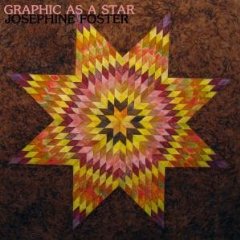Graphic As A Star is the first album that Colorado folk singer Josephine Foster has recorded for UK label Fire Records, having mounted up a sizeable catalogue of CDRs and collaborative ventures. Although the idea behind the album – to set to music 26 poems by nineteenth-century American poet Emily Dickinson – was Foster’s own, it happens to ally neatly with one of Fire’s more notable releases of recent times: the 2008 compilation Chamber Music where a wide range of (largely leftfield-leaning) artists offered music set to the poetry of James Joyce. This collection, while not perfect, is frequently captivating and, artistically, more successful overall.
Perhaps more often than on her previous discs, Foster is confident enough in the power of her own voice to let it do the bulk of the album’s work. There are a number of a capella tracks on Graphic As A Star, and the instrumentation that is employed is, you sense, constructed so as to obfuscate her vocal as little as possible. ‘In falling Timbers Buried’ (Foster’s titles quite correctly preserve Dickinson’s unusual capitalisation) places a banjo upfront in the mix, winding the ghost of Appalachian folk and old-time country through the decades. Lithe harp accompanies tracks such as ‘I See Thee Better – In The Dark -‘ and ‘My Life Had Stood – ALoaded Gun -‘ (the poet’s inscrutable use of dashes is also present here); wheezing harmonica on ‘She Sweeps With Many-Colored Brooms’ leads us, momentarily, into New York’s East Village circa 1966 or so. While the instrumentation is more stripped back than past commitments to tape, one wouldn’t deem the music as notably far outside its creator’s comfort zone. Not that there’s any reason why it ought to be.
Dickinson’s poetic style – elusive and, for literary scholars, difficult to comfortably categorise – nevertheless lends itself to the niche that Josephine Foster already occupies in the modern folk realm. One assumes that on some level, this is why the project came to fruition in the first place. As with her 2005 album A Wolf In Sheep’s Clothing, which featured her interpretations of Brahms and Schubert’s lieder songs of the nineteenth century, the casual listener might not have pegged the poems sung here as an obvious primary influence on the singer – yet time spent with Graphic As A Star makes it easier to understand how it might be a formative one.
The subjects that thread themselves through Dickinson’s verse – the recourse to morbidity, reflections on faith and innate fascination with nature – help to align her not only with the globe-spanning folk tradition, but with Foster’s previous on-record subject matter. As with Shirley Collins, the English vocalist of the 60s and 70s who is often cited as an influence on Foster, her concerns can often be workaday and prosaic, while also engaging with the metaphysical. It’s all helped along, of course, by her expressive and often extraordinary voice, which evokes prototypical gramophones and crackling wax cylinders more than any other singer currently performing (fellow cultish psychedelic folk type Marissa Nadler comes close, yet next to Foster she sounds positively… modern).
If Graphic As A Star has one failing, it’s located in the brevity of most of the tracks, which average around 100 seconds’ length. Dickinson’s poems tend to be fairly short; given that the primary focus here is intended to fall on the voice and the words being sung, often a song will be over just as you’re acquainting yourself with it. Combine this with the distance inherent to Foster’s vocal style – not that it isn’t emotionally resonant, but that you feel you’re listening to a recording from an era you never experienced – and the result is most likely not one for casual or first-time investigators to warm to. This doesn’t reflect poorly on Josephine Foster, however: she performs in typically fine style and pays worthy tribute to someone who had a greater impact on the evolution of poetry than she might have ever imagined.


